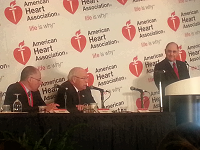Article
VP Cheney's Other Role: Heart Patient
Author(s):
Former VP Dick Cheney spoke at AHA 2014 about his experiences as a model heart patient. Speaking with his cardiologist, Jonathan Reiner, MD, of George Washington University, Cheney recounted his 5 heart attacks, a CABG procedure, defibrillator implantation, getting a left-ventricular assistive device, and at age 71, a heart from an anonymous donor.

Often called the most powerful vice president in US history, former VP Dick Cheney today recounted his life playing a very different role: model heart patient. Speaking with his cardiologist Jonathan Reiner, MD, of George Washington University Cheney recounted his 5 heart attacks, a CABG procedure, defibrillator implantation, getting a left-ventricular assistive device, and at age 71, receiving a heart from an anonymous donor.
Cheney’s litany of procedures was also a reflection on the “amazing advances in cardiac care,” in recent decades said Elliot Antman, MD, president of the AHA, who led the discussion.
Cheney (center of photo), who with Reiner has written a book about his medical voyage “An American Medical Odysssey” had his first heart attack at age 37 when he was running for Congress as a representative from Wyoming.
“I woke up at 2 a.m. with tingling in two fingers of my left hand—that was it,” Cheney said, “no crushing chest pain.” But because of family history of heart disease, he went to a local emergency room where he got the diagnosis.
His first significant attack came in 2000, likely brought on by the stress he was undergoing at the time. “It was the recount for the election, I asked the Secret Service to take me to the hospital at midnight,” he said.
Reiner praised Cheney for that decision, one that wasn’t going to help him politically, “but one of the major lessons to be learned here is that vice president has never ignored his symptoms.”
As more treatments evolved over the years, Cheney was always willing to try them. He got a stent, he had restenosis and had to be re-implanted.
At one point, Cheney said, he asked his doctor for advice—whether he should give up politics and public life and try to find something non-stressful. “The answer I got was that stress is a life spent doing something you don’t want to do,” Cheney said.
Instead he continued to take on responsibilities and high-power jobs, notably that of Secretary of Defense during the George H. W. Bush administration, and post-Bush, heading the defense contracting firm Halliburton.
Along the way he has had a quadruple bypass, taken cholesterol-lowering drugs, and—the most difficult, he said—gotten the LVAD that kept him going 20 months while he waited for a heart transplant. All the treatments were “guideline-driven” Reiner said.
Asked what advice he’d give other heart patients, Cheney thought a moment, then said, “When in doubt check it out; listen to your body.”
“You’re a model patient,” Reiner said.





